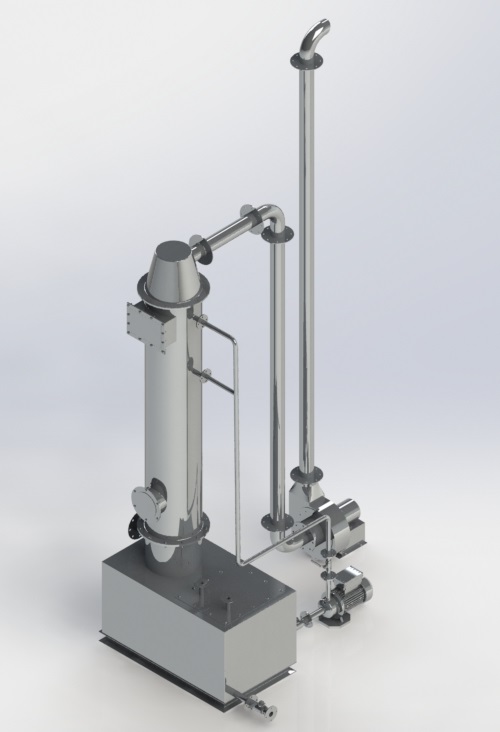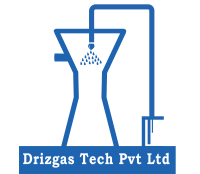Explanation
- Ammonia occurs as the by-product of a number of industrial and chemical processes. It can be highly corrosive to certain metals and other materials.
- Drizgas Tech is one of the leading manufacturer of Ammonia gas scrubber in India. We offer complete packages for our dry, wet or packed scrubber systems, including instrumentation and controls, skid-mounting of equipment, acid storage tanks, metering pumps, and installation.
- The ammonia scrubber uses a packed bed absorber to remove ammonia from a gas stream. Sulfuric acid is used as the scrubbing solution. The ammonia scrubber can handle high inlet concentrations of ammonia.
- Ammonia is a colorless gas made of nitrogen and hydrogen with a strong and distinguishable odor that occurs naturally in air, soil, and water and is also a by-product of the normal biological processes of humans and animals.
- Ammonia is poisonous if inhaled in great quantities and irritates the eyes, nose, and throat in lesser amounts.
Exposure limit of ammonia
- OSHA: Permissible Exposure Limit: 50 parts per million (ppm) averaged over an eight hour work day. This is the standard that must be met in every work place.
- NIOSH: Recommended Exposure Limit (REL): 25 ppm averaged over an eight-hour work day. NIOSH also says that there should be a Short Term Exposure Limit (STEL) of 35 ppm during any 15 minute period in the day. No worker should be exposed to more than that amount over any 15 minute period.

Mechanism
- A solution containing sulfuric acid (H2SO4) in water is recirculated in a loop process. The chemical reagent is introduced at the top of the vertical tower through a distribution system designed by Drizgas Tech and travels down through and across the media bed. The random packed mediais typically made from polypropylene material and is resistant to the low pH of the solution.
- The media bed is supported by a false bottom that separates the media bed from the solution tank below. Then the air travels upward it meets the acidic solution and a reaction occurs to neutralize the ammonia gas.
- Scrubbing liquid is evenly introduced above the packing and flows down through the bed. The liquid coats the packing and establishes a thin film.
- The pollutant to be absorbed must be soluble in the fluid. In vertical packed bed scrubber, the gas stream flows up the chamber (countercurrent to the liquid).
- Physical absorption depends on properties of the gas stream and liquid solvent, such as density and viscosity, as well as specific characteristics of the pollutants in the gas (e.g., diffusivity, equilibrium solubility).
- The most common acid used in air scrubbers is Sulfuric Acid, due to its availability, low cost, and non-volatility. The product formed when Ammonia is scrubbed with Sulfuric Acid is Ammonium Sulfate, which is a common fertilizer ingredient.
- Caustic can be used to adjust the pH of the waste stream prior to disposal.
- The resulting byproduct, a form of salt, is collected and removed through the wastewater blow-down, as the treated air stream is exhausted through the stack.
- Due to its toxicity, ammonia gas is a regulated compound that needs to be treated below established limits before it is released into the atmosphere.
- Depending on the quantity of NH3 being scrubbed, the Ammonium Sulfate by-product may be utilized as an additional revenue stream. Ammonia air scrubbers incorporate a variety of gas-liquid contacting techniques, including packed beds, spray chambers, and water jets.
Chemistry of Ammonia with H2SO4
This is often by reacting the sulfuric acid with ammonia, or ammonium hydroxide solution, to make ammonium sulfate, (NH4)2SO4.
2NH3 + H2SO4 —-> (NH4)2SO4
Ammonia + sulfuric acid → Ammonium sulfate
Advantages
- Can handle high temperature streams
- Versatile
- Processes high moisture streams
- Smaller space requirements
- Can be retrofitted into current equipment (in some cases)
- Provides cooling of heated gases
- Higher removal capabilities than other equipment
- Lower cost of purchase
- Can remove gases and particulates, in a single unit
- Able to neutralize highly corrosive gases and dusts
- No secondary dust source
- No temperature limits
- Can handle highly flammable dusts, with very little risk of explosion
- Several customizable options, based on specific output and applications, often allowing for a reduction in cost.
Features
- Can handle air flow rate from 100 to 30,000 CFM
- Removal method is Absorption / Chemisorption
- Material of Construction: PP, FRP, PP+FRP, MS+FRP, SS 304, SS 316
- High efficiency Tellerette®Tower Packing removes soluble/reactive gases, solid particulate and liquid droplets down to 7 microns
- Lower shell serves as integral sump for recycle of liquid
- Spray nozzles accessible from top of unit
- Entrainment separators prevent liquid carryover
- Special multi-bed packing designs accommodate different scrubbing solutions for removal of multiple contaminants
- Efficiency up to 99 %
Additional accessories
- Continuous pH monitoring system for scrubbing liquid
- Dosing system for adjusting pH
- PLC operated control panel
- SCADA system
Design considerations
- Air flow rate of exhaust gas
- Velocity across the column
- Pollutant concentration in the gas
- Solubility of pollutants in solvent/water
- Reaction rate
- Liquid to Gas (L/G) ratio
- HTU (Height of Transfer Unit)
- Packing material size, shape and type
- Packing depth
- Gas temperature
Applications
- Storage room exhaust scrubbing
- Emergency ammonia scrubbing
- Storage tank vent scrubbing
- Process vent scrubbing
- Textile industries ammonia scrubbing
- Fertilizer industries ammonia scrubbing
